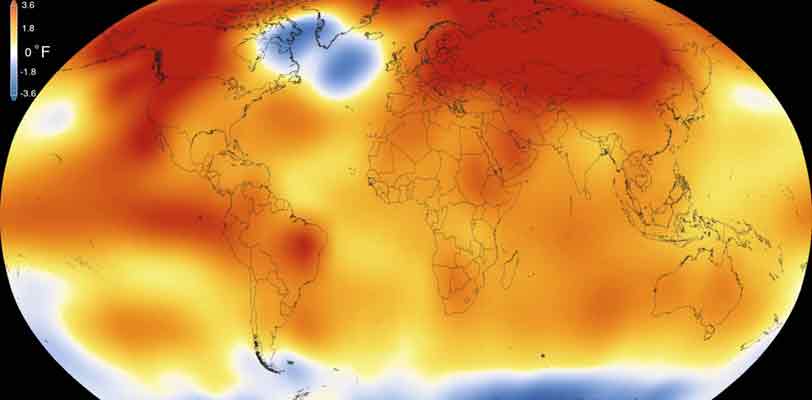WASHINGTON -- Scientist say 2015 temperatures on Earth were the warmest in recorded history, shattering a record set only a year before. It was the third year in a row for temperatures to climb.
Earth’s 2015 surface temperatures were the warmest since modern record keeping began in 1880, according to independent analyses by two agencies - NASA and the National Oceanic and Atmospheric Administration (NOAA).
Globally-averaged temperatures in 2015 shattered the previous mark set in 2014 by 0.23 degrees Fahrenheit (0.13 Celsius). Only once before, in 1998, has the new record been greater than the old record by this much.
“The whole system is warming up, relentlessly,” said Gerald A. Meehl, a scientist at the National Center for Atmospheric Research in Boulder, Colo.
A few more years of analysis are needed to know for certain, but the back-to-back records of 2014 and 2015 may have put the world back onto a pattern of rapid global warming.
There was a period of slow warming dating to the last powerful El Niño, in 1998.
 U.S. Rep. Lamar Smith, R-Tex.Politicians have attempted to claim that greenhouse gases are not a problem seized on that slow period to argue that “global warming stopped in 1998.” Similar statements have been made by Republican presidential candidates.
U.S. Rep. Lamar Smith, R-Tex.Politicians have attempted to claim that greenhouse gases are not a problem seized on that slow period to argue that “global warming stopped in 1998.” Similar statements have been made by Republican presidential candidates.
Conservative leaders claim that any new environmental regulation will slow the U.S. economy and kill jobs, a stand that has not been proven.
NOAA scientists have been at odds with U.S. Rep Lamar Smith (R-Tex.) over global temperature research since last year. Smith claims there is evidence from a government whistle-blower that NOAA doctored the data. Smith and whistle blower say the data was rigged, but havn't offered proof.
Independent researchers claim that Smith's tactics of using subpoenas and closed hearings amount to intimidation.
Smith's committee cut more than $300 million 2016-2017 NASA budget. Smith calls environmentalists "climate change alarmists."
Seven scientific organizations - the American Association for the Advancement of Science, the American Chemical Society, the American Geophysical Union, the American Meteorological Society, the American Statistical Association, the Ecological Society of America, and the Geological Society of America. - have expressed "grave concern" over Rep. Smith's communications demandingdata and notes that are not public records
The 2015 temperatures continue a long-term warming trend, according to analyses by scientists at NASA’s Goddard Institute for Space Studies in New York. NOAA scientists concur with the finding that 2015 was the warmest year on record based on separate, independent analyses of the data. Because weather station locations and measurements change over time, there is some uncertainty in the individual values in the government index. Taking this into account, NASA analysis estimates 2015 was the warmest year with 94 percent certainty.
The planet’s average surface temperature has risen about 1.8 degrees Fahrenheit (1.0 degree Celsius) since the late-19th century, a change largely driven by increased carbon dioxide and other human-made emissions into the atmosphere.
Most of the warming occurred in the past 35 years, with 15 of the 16 warmest years on record occurring since 2001. Last year was the first time the global average temperatures were 1 degree Celsius or more above the 1880-1899 average.
Phenomena such as El Niño or La Niña, which warm or cool the tropical Pacific Ocean, can contribute to short-term variations in global average temperature. A warming El Niño was in effect for most of 2015.
“2015 was remarkable even in the context of the ongoing El Niño,” said Gavin Schmidt, Goddard Institute director “Last year’s temperatures had an assist from El Niño, but it is the cumulative effect of the long-term trend that has resulted in the record warming that we are seeing.”
Weather dynamics often affect regional temperatures, so not every region on Earth experienced record average temperatures last year. For example, NASA and NOAA found that the 2015 annual mean temperature for the contiguous 48 United States was the second warmest on record, the agency's statement said.
NASA’s analyses use surface temperature measurements from 6,300 weather stations, ship- and buoy-based observations of sea surface temperatures, and temperature measurements from Antarctic research stations.
NOAA scientists used much of the same raw temperature data, but a different baseline period, and different methods to analyze Earth’s polar regions and global temperatures.
The full 2015 surface temperature data set and the complete methodology used to make the temperature calculation are available at:
http://data.giss.nasa.gov/gistemp/




